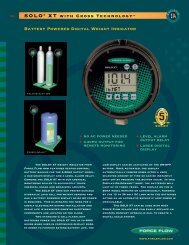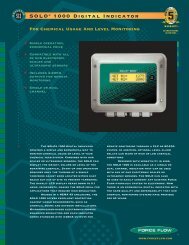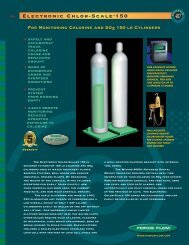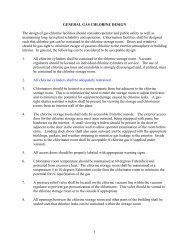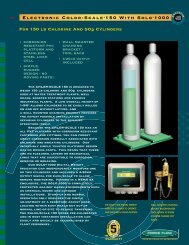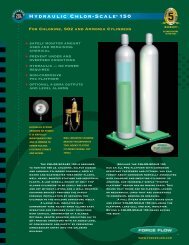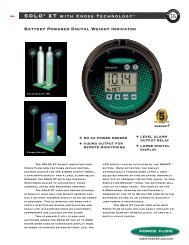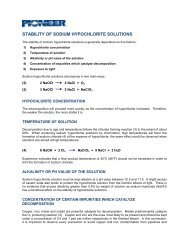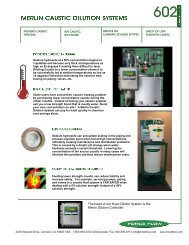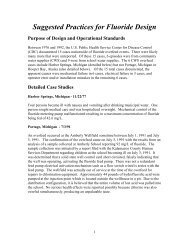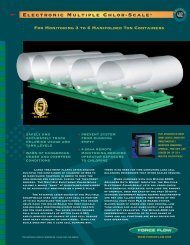Sodium Hypochlorite Handbook - Force Flow
Sodium Hypochlorite Handbook - Force Flow
Sodium Hypochlorite Handbook - Force Flow
Create successful ePaper yourself
Turn your PDF publications into a flip-book with our unique Google optimized e-Paper software.
2.4 <strong>Sodium</strong> <strong>Hypochlorite</strong> DecompositionThe consumer must understand the reasons for decomposition of sodium hypochlorite to successfullypurchase and utilize the product and to eliminate “oxygen locking” and piping systems plugging.There are two decomposition pathways of sodium hypochlorite.The dominant pathway is as follows:3NaOCl = 2NaCl + NaClO3 (Chlorate)This decomposition can be created two major ways.2.4.1 <strong>Sodium</strong> <strong>Hypochlorite</strong> Decomposition By Chlorate Formation Path #1If during production of the sodium hypochlorite the reaction of chlorine and caustic occurs in a low pHregion of the reactor (typically less than 10 pH), hypochlorous acid is formed. This will result in chlorateformation. Refer to Section 5.0 References.In most batch production systems for sodium hypochlorite using the original methods is common in the1950 & 1960’s, high levels of chlorate can be produced during the reaction process. During the 70’s,80’s and 90’s most manufacturers have converted to continuous production of sodium hypochloriteresulting in good control of the pH at the reaction point and thus reduced chlorate formation. However,it should be noted that within the continuous sodium hypochlorite manufacturing group, individualmethods of operation will greatly affect the levels of chlorate produced during the reaction. Forexample, if packed towers are utilized for the reaction of caustic and chlorine, high levels of chloratescan be expected if the excess caustic in the column drops below approximately 1.5% by weight excess.It should also be noted that the strength of sodium hypochlorite produced during the reaction will alsoaffect the levels of chlorate. Regardless of the method used in the sodium hypochlorite production, thatproduction method will create high levels of chlorates if higher strengths of sodium hypochlorite areproduced.2.4.2 <strong>Sodium</strong> <strong>Hypochlorite</strong> Decomposition By Chlorate Formation Path #2<strong>Sodium</strong> hypochlorite after production will decompose due to initial strength and pH, storagetemperature, sunlight, and contaminants such as heavy metals and suspended solids such as calciumand magnesium.The normal rate of sodium hypochlorite without salt, sunlight, heavy metals and contaminants (whichcan be easily controlled) with a pH of 11.86-13 can be expressed as:Rate = K2 (OCl - ) 2 (Reference #1)Therefore the strength of the bleach during storage and the amounts of chlorate can be calculatedusing the predictive chemical-modeling program created by Gilbert Gordon and Luke Adam.(Reference #1)2.4.2.1 Method #1 to Reduce <strong>Sodium</strong> <strong>Hypochlorite</strong> DecompositionChlorate Formation Path #2As indicated by the decomposition formula, sodium hypochlorite has a 2 nd order rate of decomposition.This means that a 200-gpl available chlorine sodium hypochlorite solution without salt will decompose 4times faster than 100-gpl available chlorine sodium hypochlorite if all other factors such as storagetemperature are the same.However, at a constant temperature, the rate of NaOCl decomposition is also affected by the total ionicstrength of the solution. Since salt is produced in the reaction of chlorine and caustic, this increase in



